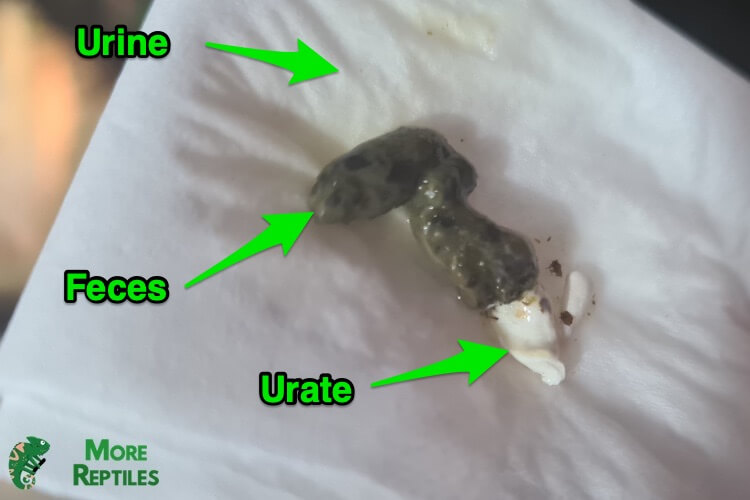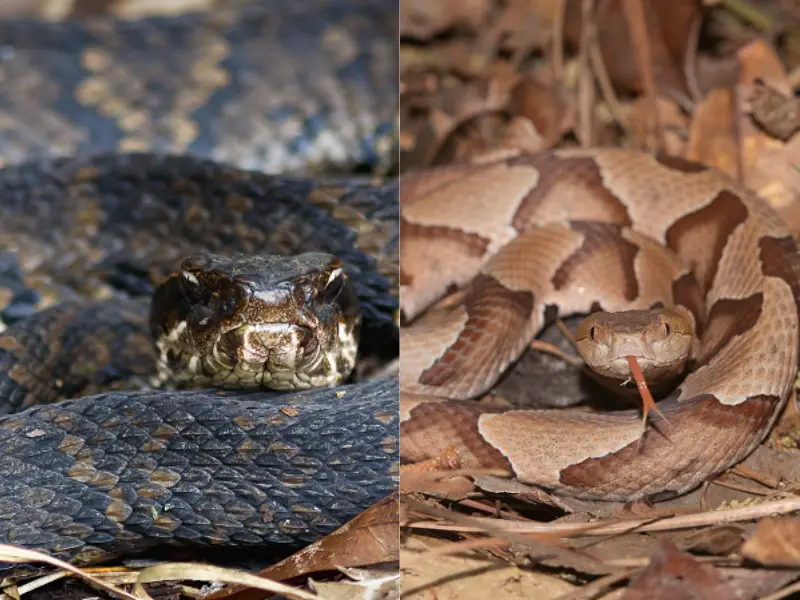Have you ever watched a Bearded Dragon’s toileting behaviors and wondered if they pee? This question certainly has crossed my mind during my many years keeping them!
One thing I have found is that the answer is a little more complex than a simple yes or no.
Perhaps you have noticed a change in the color of your dragon’s urate and are wondering why.
In this article we explore their mysterious urination process. We shed light on the white substance called urate, often mistaken for urine. And finally, we discuss what is considered healthy, and when it is time to seek the advice of a qualified vet.
What to Know
- Beardies do pee, but it is mostly excreted in a solid form that is different to mammals.
- Bearded Dragons produce urine as a clear-yellow liquid waste and as a white and sometimes powdery substance called urate. Urate is a concentrated form of urine.
- Sometimes we don’t see the clear-yellow liquid urine because it is either absorbed by the urate or has dried out.
- These lizards produce waste in three parts: a solid waste known as poo or feces, a clear-yellow liquid called urine or pee and a white solid waste called the urate.
- Babies and juveniles tend to defecate a few times a day to every other day, while it is not unusual for a healthy senior to defecate once a week.
Do Bearded Dragons Pee?
There is a common misconception that Bearded Dragon’s do not pee, but this is not true!
Bearded Dragons do pee, but for the most part it is excreted in a moist, sometimes powdery substance called urate. Urate is a white log-shaped substance that consists mainly of uric acid, a byproduct of protein metabolism.
Reptiles like Bearded Dragons excrete uric acid as a solid product to conserve water within their body. This allows them to survive in arid desert-like environments where water is scarce. They have evolved to conserve water by separating their pee into two forms:
- A clear-yellow liquid (urine) that may have a slightly yellow tint.
- A moist white solid product (urate).
Urine is the liquid part of the waste produced by the kidneys and is similar to the urine produced by mammals. Urate is the solid part of the waste produced by the kidneys.
If you have never seen a Bearded Dragon’s pee, then don’t fret!
It is common that keepers don’t notice it, as it’s either absorbed by the urate, or has dried out by the time you clean it up.
Urine Explained
In Bearded Dragons urination and defecation happen simultaneously.
This means a normal elimination should include three parts (as seen in the picture above): clear liquid urine, white chalky urate, and a formed greenish or brownish poop.
Urate is commonly white or off-white due to the high concentration of uric acid crystals. These crystals have a white appearance, giving the urate its characteristic color. It is not unusual for it to have a yellowish or beige tint as well. The color may change depending on hydration levels, diet, or illness.
Baby and juvenile dragons typically pass stool multiple times per day, or every other day due to their large consumption of proteins.
Healthy adults, especially in later stages of life, commonly excrete waste once a week. This is considered normal because of their dietary switch to ~80{a47be734f0df8d7f120a7df290cf380c79376e8356d1aab405383bb23aa6ce67} veggies and ~20{a47be734f0df8d7f120a7df290cf380c79376e8356d1aab405383bb23aa6ce67} insects.
In our Bearded Dragon owners survey, the most common answer for “how many times a week does your bearded dragon pee or poop” was once.

When my Bearded Dragon first arrived home I remember having “Helicopter-Mum” mode on! I waited and watched him poop, and booked it straight to the exotic vets. The picture above is the very poop I gave them!
Fortunately, my beardie was in very good health and the poop was described as “healthy and perfect” by his veterinarian.
Urine vs Urate
Bearded Dragons produce urine as a clear-yellow liquid waste and as a white and sometimes powdery substance called urate.
Author Tip: Beginners often think urate is pee and that they do not actually excrete liquid waste. This is wrong, they also excrete a clear-yellow liquid urine.
Bearded Dragon Urate
Urate in reptiles develops due to protein metabolism.
To understand Bearded Dragon urate a little better it is best to explain what urine is.
Urine is a waste product, made up of water, salts and dissolved waste products that the body no longer requires. These substances can often be harmful to other organs which is why they are eliminated.
In Bearded Dragons, urate is the uric acid produced by a chemical process as the body breaks down waste and harmful substances.
Healthy Bearded Dragon urate is white and well-formed, but never hard (see picture below).

When urate presents in unusual forms, it is a common indicator your beardie is sick. Urate shouldn’t display any discolouration or appear watery or loose. It should be consistent and remain the same until there is a change in
their diet.
Discolored urate that appears with a yellow tip can sometimes be a symptom of excess calcium or vitamin supplements. An overuse of supplement powder can also cause a crystalline appearance. To remedy this, simply decrease the supplement dosage.
Smell
Bearded Dragon pee does not have a strong odor. If you aren’t putting your nose to it, you probably won’t smell anything. However, since the urate in many cases is expelled at the same time as feces, it can have a light, musky or earthy smell.
If your Bearded Dragon emits a strong urine-like odor, it may indicate a health issue.
Foul smelling urine, so pungent that it could cause a wince or two, could be a sign of a urinary tract infection, tail rot, parasites, or severe dehydration.
Bearded dragons require regular and consistent water throughout the day to remain in good health and to prevent the build-up of uric acid and other toxins.
As a responsible keeper, it is important to observe and monitor your Bearded Dragon’s urination habits. Any significant changes in frequency or appearance should be noted. A sudden increase or decrease in urination, presence of blood, or any signs of discomfort may also indicate an underlying health issue.
Below I have put together a table of the different variants of urate, the possible causes and what you should do.
| Urate | Cause | Action |
|---|---|---|
| White firm cylindrical/log-shaped, few mm to 1-3 cms in length | Healthy / Normal | Continue to monitor your Bearded Dragon’s pee and urate. |
| Firm dark yellow-amber | Dehydration and/or consuming a diet rich in pigments, particularly beta-carotene i.e. yellow, orange, and green leafy fruits and vegetables like carrots, spinach, tomatoes, sweet potatoes and squash). | Fruit should be fed rarely, with leafy greens such as kale, collard greens, mustard greens, dandelions, watercress, endives, turnip greens etc as their staple. |
| Mustard/bright yellow-green | Liver inflammation/damage. | Consult a veterinarian. |
| Reddish-brown/dark tarry | Blood of any description may indicate abnormally hard feces, impaction (from using the wrong substrate), a parasitic infection or a serious intestinal disease. | Consult a veterinarian. |
| Loose and very runny | Diet changes, oerhydrated, or parasites. | Recent changes in diet are a possible cause, however if it still persists, it is best to consult a veterinarian. |
Remember that changes in urine and urate should not be assessed in isolation.
It is important to observe the feces too, as it comes out of the cloaca together with the urine. Here is our article all about poop, the colors and types in all its glory.
Urate Plugs
Your bearded dragon may also occasionally generate urate plugs.
I can still remember how my curiosity was piqued when I discovered my first urate plug attached to my beardie, and I was quite concerned.
Urate plugs form on the inside of the vent and beneath the tail.
This urate mass can trap excrement, causing a build-up within the colon.
Some Bearded Dragons will pass the urate plug naturally; however, oftentimes the plug can become trapped. Veterinary assistance and treatment is required, commonly with warm soaks.

Summary
Bearded Dragons do pee and it is usually a clear-yellow liquid.
Sometimes we don’t see Bearded Dragons pee because it is either absorbed by the urate or has dried out. The white substance called urate is often mistaken for urine.
Understanding the appearance, color, smell, and frequency of urate and urine production is important for monitoring the health of your Bearded Dragon.
Healthy toileting behaviors are strongly reliant upon good husbandry and care. A healthy urate makes way for a happy healthy dragon and that is what every good owner should strive to provide.




